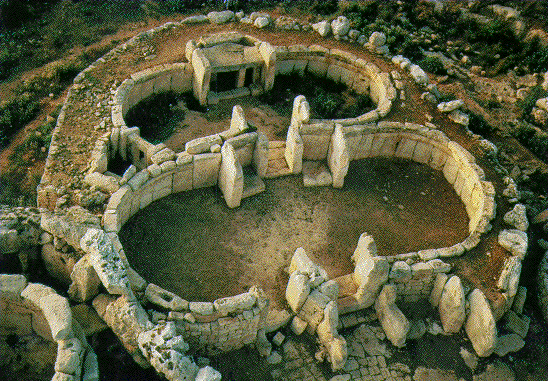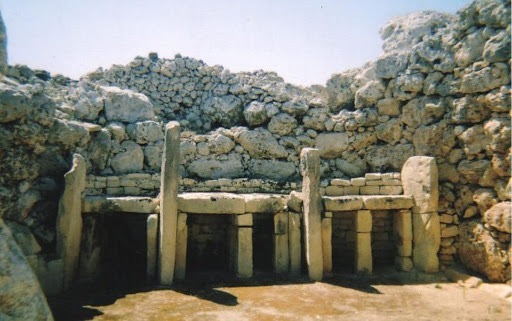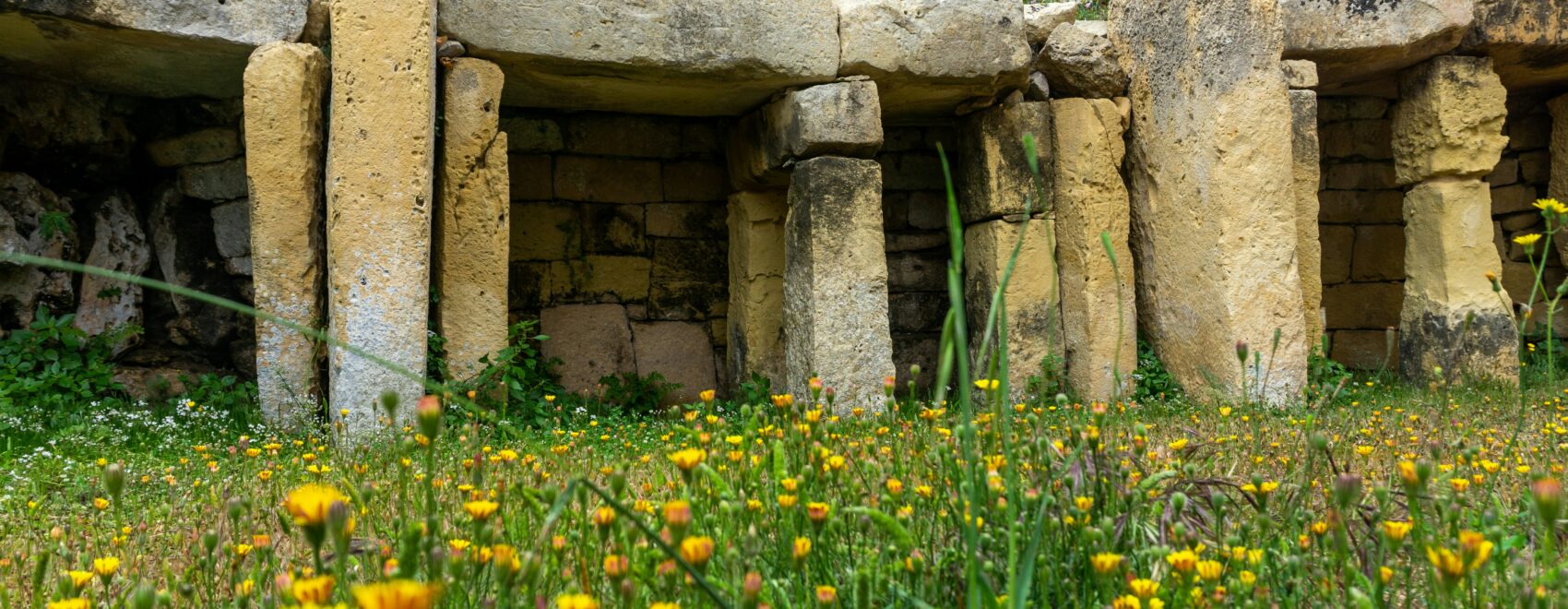Journey with Me Blog Series
Location: Island of Gozo (Malta)
My experience there
I visited Ġgantija with a small group of ISTA companions, and with a clear intention. We were going into one of the megalithic temples of Malta, some of the oldest remaining sacred sites in the world, to meditate and pray. Walking into the temple, I did my best to empty my mind of any preconceived ideas, forgetting what I knew about the history of the Neolithic temples in Europe, and opening myself up for whatever wanted to come.
Lowering our voices into a respectful silence, we spontaneously split up, each going in their own direction to find some solitude. I sat down on the ground and closed my eyes. The visions came almost immediately. What I saw was something I had never quite experienced before.

As soon as I closed my eyes, sitting cross-legged on the temple floor, I felt transported to a time that I couldn’t understand with any of my mental frameworks. And in there, I felt a clear, powerful, and simple Feminine presence. This was definitely an archetype, yet different from all the others I’d ever encountered. The Feminine presence I met in Ġgantija was untouched, unscathed by the archetypal trauma between the Masculine and the Feminine that had dominated the last several centuries.
During my travels, I’ve been to many sacred sites that are relevant to the story of the Feminine archetypes. From the Temple of Hekate, to Chartres Cathedral, to the Church of Mary in Ephesus, in each of those sites I had the opportunity to access one of the “chapters” in the century-long journey of Feminine archetypes, and their relationship with the Masculine ones. But virtually all of those sacred sites were built in the last two thousand years. The history of the Feminine and Masculine archetypes in this period hasn’t been easy. There’s been violence, suppression, and grief. There’s also been a lot of passion and Eros. It’s been messy, and still is.
The Feminine at Ġgantija knew nothing of the rivalry, the oppression, the war, the abuse, the longing for reconciliation, the disillusionment, the passion, that has dominated the relationships between Masculine and Feminine archetypes for the last two thousand years. She was complete, whole, and in full acceptance of a Masculine that she had no conflict, but also no particular interest in. The Feminine of Ġgantija coexisted peacefully with the Masculine. Not relating, perhaps not even cooperating, but coexisting.
After a few minutes, I emerged from my reverie. It felt as if a weight had been lifted off my body. I was refreshed. I realized that, in all my experiences and interactions, I had never been able to connect to a Feminine that was completely, utterly unaffected by personal or collective trauma. And yet what I had just seen inhabited a far away and forgotten place. The power of Ġgantija, her influence on today’s reality, was minimal. Finding her took a conscious act of will.
The encounter with the deity at Ġgantija also brought up some difficult questions. If there had been a time when Feminine and Masculine archetypes could co-exist undisturbed, how have we come to the current state of affairs?
My experience at Ġgantija gave me a possible way to approach this complex question. The Feminine I met didn’t seem to have any conflicts with the Masculine deities/archetypes, but neither did I sense any passion, or even deep cooperation. The image that comes to me is how young children can coexist in a kindergarten, each one in their own world, interacting here and there, but mostly blissfully aware of each other. Those children in many ways behave like all-powerful, innocent, blissful Gods and Goddesses, like the ones at Ġgantija.
But when those children grow into the possibility of a relationship, particularly through adolescence, things become so much more complicated. Feelings arise, conflicts, desires, and expectations that they had not known before. Perhaps something similar happened to our deities and archetypes. In transitioning into a phase of “adolescence,” the relationship between the Feminine and Masculine deities became more passionate, intimate, and sadly also in many cases abusive and violent.
Was this phase of conflict a necessary step towards real cooperation between archetypes? It is certainly tempting to see it this way, and I’m inclined to think that, somehow, there was no possibility of cooperation without first going through a long phase of grinding conflict. But ultimately, it is for everyone to make up their own mind about how we came to the current state and whether there is a way out.
A little bit of history:
Ġgantija is one of several sacred sites in the Mediterranean islands of Malta and Gozo. These temples are often called “megalithic” because of their construction style based on large stone slabs.

The two Ġgantija temples were erected sometime in the fourth millennium BC, a time in humanity’s history that most of us aren’t very familiar with. Nevertheless, prominent archeologist Marija Gimbutas has offered a tantalizing picture of the societies that inhabited Southern and Eastern European lands during the Neolithic and Bronze Age (6500 – 3500 BC). She coined the term “Old Europe” to describe a fascinating, if perhaps idealized, reconstruction of communities that gathered around the worship of a female Goddess.
If you’re interested in getting a fuller picture of the archetypal history of the evolution of human consciousness, particularly through the lens of the Feminine / Masculine polarity, I suggest reading my paper Bringing Back Persephone, which is based on the teachings of Anne Baring. Baring offers an understanding of two main phases in the evolution of consciousness. The first one, which she calls the “Lunar era,” covers all of the Paleolithic, Neolithic, and Bronze Age. This means all of recorded human history until approximately two thousand years before the birth of Christ.
The second phase, the “Solar era,” began in roughly 2000 BC and continues to this day. Most of the archetypes we are used to dealing with today were shaped and formed during the Solar Era. This was a time when the Masculine deities rose in prominence and power, most of the time in a brutal, violent way. It’s the time when Tiamat, the primordial Goddess of Babylonian mythology, is mercilessly cut in half by Marduk, one of the first Sun-gods that embody the new violent, brutal power of the Masculine.
But Ġgantija is much older than that, with the best estimates locating its construction at approximately 3600 BC.
Gimbutas’ “Old Europe” hypothesis matches almost perfectly with Anne Baring’s concept of “Lunar Era.” Naturally, mainstream academia has since picked apart Gimbutas’ theory and accepted some of it, while rejecting her methodology and sometimes her conclusions.
On an archetypal level, however, Gimbutas’ hypothesis makes perfect sense. In the process of the growth of human consciousness, a phase of connection, even “merging” with the Divine Feminine archetypes is no surprise. After all, every human consciousness has been gestated in a woman’s womb, which in turn explains the relationship to Nature as both a nourishing and terrifying Mother. But as Life continues stimulating incessable change and progress, the human consciousness naturally tends to “individuation,” a complex process that, at its base, requires a struggle and a separation of individual from collective consciousness, so that individual consciousness can find its own center of gravity.
If the model of individuation has any validity, then the archetypal transition between Lunar and Solar eras starts making more sense. We see consciousness violently struggling to disengage from the symbiotic and hypnotic union with the Feminine archetype of the Mother Goddess. We see consciousness progressively associating itself with more independent, proud, and violent Masculine archetypes.
We witness the immense power that consciousness acquires through this process, but also the incredible amount of hurt and trauma that it generates. And finally, we see our present selves laboriously trying to restore some kind of balance, before the damage done to Nature, to our own bodies, and to the archetypal Feminine is too great.
As we continue collectively rebalancing the Feminine and Masculine archetypes, connecting with the unscathed, powerful Feminine at Ġgantija can be an incredible source of inspiration.
When you are there
First of all, a word of warning. As peaceful as the experience at Ġgantija was for me, I sense that it might be disturbing for some. If my visions have any grounding, whether in the physical or in the psychic realms, then connecting with an archetype that is so ancient, literally coming from another phase of our evolution, can be disorienting. And yet, it is such a blessing that in the middle of Europe, in an easily accessible place, we can get in contact with such ancient psychic constructs.
I believe that worship in the megalithic temples of Malta was less structured and formalized than it is in some modern temples of today. Whatever it may be, I suggest you wander in Ġgantija at your own pace, and find the spot that resonates for you to sit down and close your eyes. There’s some speculation that a certain indentation in the wall may have been an altar, but I personally didn’t care so much. Ġgantija is welcoming, open, and available. Find your way there, and enter into an inner contemplation into what may have been the spiritual landscape of women and men who lived centuries before the most ancient records of written history.


Leave a Reply